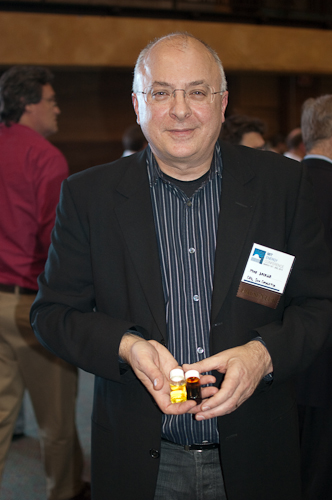Sun Catalytix Seeks Second Act with Flow Battery
MIT spin-off Sun Catalytix has had to put its bold vision of enabling the hydrogen economy on hold. But it still has aggressive technical goals.

The Cambridge, Massachusetts-based company has spent the last year and a half designing a flow battery for grid storage and plans to have a prototype later this year, CEO Mike Decelle tells me. The hope is to test the kilowatt-scale system this year and raise additional funding for further development by the end of the year.
Flow batteries are one of most attractive battery technologies for storing multiple hours of energy on the grid. They can be used to smooth out the variable supply of wind and solar farms or provide back-up power for buildings or campuses with on-site power generation. A commercial product from Sun Catalytix would be able to deliver one megawatt of power for four to six hours and fit in a 40-foot shipping container, Decelle says.
There are already dozens of flow batteries connected to the grid made by companies with vanadium and zinc bromide chemistries. Sun Catalytix is using “designer molecules” made from abundant materials that are environmentally benign and will yield low costs, Decelle says. The company is targeting a price of $200 to $250 per kilowatt-hour of capacity, far less than long-lasting batteries now on grid.
The move to focus on flow batteries is a dramatic turn for Sun Catalytix. The startup was spun out of MIT in 2009 to commercialize a low-cost catalyst developed by professor Daniel Nocera. With it, Nocera envisioned an “artificial leaf” that could cheaply strip the hydrogen from water and use the hydrogen in a fuel cell to make electricity. The company raised venture capital from Polaris Venture Partners and from Indian conglomerate Tata, which expressed interesting in its technology for distributed energy. It also landed an ARPA-E grant for a material that can produce hydrogen from water directly from solar energy. (See, A Greener Artificial Leaf.)
The vision of using a low-cost, solar-powered electrolyzer brought heaps of publicity to the company and Nocera, who advocated using the technology in developing countries. At the time, many venture capitalist companies were willing to invest in companies formed to commercialize lab research. But as the experience at Sun Catalytix shows, development times in material science are typically many years and require a substantial amount of capital to bring to market.
Decelle joined the company in June of 2011 and by the fall, it was clear the company had to pursue a shorter-term commercial market. “That (artificial leaf) technology tends to rely on hydrogen infrastructure. But when you think about that in venture capital time scales, it’s a tough pitch,” he says.
The company, which in the process of filing for patents around the flow battery technology, is being quiet about the materials it will use in a flow battery, but the chemistry will yield a higher power density than traditional designs, Decelle says. “It’s the right earth-abundant metals in the right molecular framework,” he says. Increasing the power density of a flow battery directly translates into lower cost because more power can be generated from existing components.
The mechanics of its flow battery itself will be traditional: there will be two large tanks that hold an aqueous electrolyte, which are pumped into a single tank with a membrane separating the two liquids. When flowed in one direction into the “stack,” an electrochemical reaction occurs across the membrane to produce a flow of electricity. To recharge the device, the liquids are pumped in reverse.
About half the 26 people at SunCatalytix are chemical engineers and the other half are engineers, many of whom are from the fuel cell industry, Decelle says. The performance of flow batteries, which are similar to fuel cells, has improved significantly over the past few years because engineers are able to take advantage of work on membranes and other components of higher-power fuel cells.
Sun Catalytix faces a broad set of competitors vying to sell grid energy storage systems, which have very high demands for safety, cost, and reliability. As for the original hydrogen-producing electrolyzer work, Decelle says it’s not completely scrapped, just on the shelf while the company’s chemical engineers focus on a commercial product. Nocera and other researchers, meanwhile, continue to do research on improving the efficiency of a hydrogen-producing solar device.
Keep Reading
Most Popular
Large language models can do jaw-dropping things. But nobody knows exactly why.
And that's a problem. Figuring it out is one of the biggest scientific puzzles of our time and a crucial step towards controlling more powerful future models.
The problem with plug-in hybrids? Their drivers.
Plug-in hybrids are often sold as a transition to EVs, but new data from Europe shows we’re still underestimating the emissions they produce.
Google DeepMind’s new generative model makes Super Mario–like games from scratch
Genie learns how to control games by watching hours and hours of video. It could help train next-gen robots too.
How scientists traced a mysterious covid case back to six toilets
When wastewater surveillance turns into a hunt for a single infected individual, the ethics get tricky.
Stay connected
Get the latest updates from
MIT Technology Review
Discover special offers, top stories, upcoming events, and more.